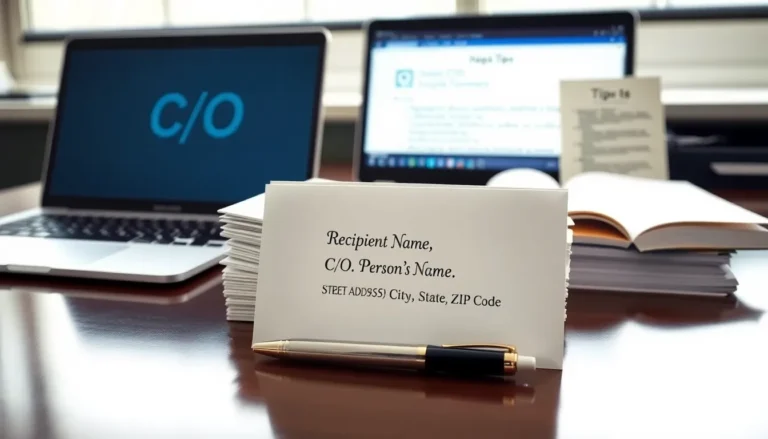In the digital world, URLs are like the street signs guiding users through the vast internet landscape. But what happens when those signs get a little too quirky? Enter Python URL encoding—a superhero in disguise that transforms those tricky characters into a friendly format. It’s like putting a bowtie on a wild child; suddenly, everything looks polished and professional.
Table of Contents
ToggleOverview of URL Encoding in Python
URL encoding converts characters into a format suitable for transmission over the internet. It replaces unsafe characters with a percent sign followed by two hexadecimal digits.
What Is URL Encoding?
URL encoding refers to the process of converting non-ASCII characters into a format that can be transmitted through URLs. Characters like spaces, punctuation, and symbols can disrupt URL functionality. For instance, a space gets encoded as %20, ensuring proper interpretation by web servers. This method adheres to standards established by the Internet Engineering Task Force (IETF) in RFC 3986.
Importance of URL Encoding
URL encoding plays a crucial role in web communication. First, it maintains the integrity of data during transmission. By encoding special characters, developers prevent errors and misinterpretations of the URL. Secondly, it enhances security by mitigating vulnerabilities related to user input. Lastly, proper encoding contributes to SEO by ensuring that web addresses remain functional and user-friendly, influencing click-through rates positively.
Methods for URL Encoding in Python

Python offers several methods for URL encoding, making it simple to handle unconventional characters in URLs.
Using urllib.parse Module
The urllib.parse module provides built-in tools for URL manipulation. Functions like quote() and quote_plus() handle encoding efficiently. quote() encodes all characters except for those considered safe, while quote_plus() replaces spaces with plus signs, making it ideal for query strings. To utilize these methods, import the module and call the desired function with the string to be encoded. This approach adheres to standards and effectively prepares data for web transmission.
Implementation of encode() Method
The encode() method plays a pivotal role in URL encoding strings. When invoked on a string, this method transforms characters to a specified encoding format, typically UTF-8. For URL encoding purposes, it requires a following transformation using the quote() function. The combination of these methods ensures a seamless encoding process. Examples clarify usage: my_string.encode('utf-8').decode('utf-8') handles common characters accurately, creating compliant URLs for web applications.
Using requests Library for URL Encoding
The requests library simplifies the process of URL encoding, particularly when handling web requests. By passing parameters as a dictionary to requests.get() or requests.post(), the library manages encoding automatically. This feature saves developers from manual encoding complexities. For example, using requests.get('http://example.com', params={'key': 'value'}) encodes parameters as part of the URL, ensuring correct transmission. Utilizing this library enhances user experience through efficient URL handling during web interactions.
Common Use Cases for URL Encoding
URL encoding serves various essential functions in web development. Understanding common scenarios helps clarify its importance.
Handling Special Characters
Special characters often disrupt URL functionality. Characters such as spaces, ampersands, and question marks require encoding to prevent misinterpretation. For example, a space becomes %20, while an ampersand is represented as %26. Encoding these characters ensures browsers and web servers process URLs accurately and consistently. This method maintains the integrity of the data and guarantees users access to the intended resources without errors.
Encoding Query Parameters
Query parameters frequently contain special characters that necessitate encoding. When forming URLs, including characters like equals signs and ampersands can cause conflicts in parameter parsing. Each character needs transformation to ensure the server correctly interprets values. The urllib.parse module in Python provides tools for this, simplifying the encoding process. Using these tools, developers can automatically encode parameters, reducing errors and enhancing the usability of web applications.
Best Practices for URL Encoding in Python
Proper URL encoding is crucial for maintaining the integrity of URLs. Developers should always ensure their encoded URLs conform to standards, which prevents errors when interfacing with web services. Any special character, such as spaces or symbols, requires careful attention during encoding. Using Python’s urllib.parse.quote() correctly converts these characters. For example, a space translates to %20, while an ampersand becomes %26. This thoroughness guarantees that URLs are functional and interpretable by web servers.
Ensuring Proper Encoding
Proper encoding practices help maintain functionality in web applications. Always specify the appropriate encoding format, using UTF-8 as the default. When using urllib.parse.quote(), providing the optional safe parameter can prevent certain characters from being encoded. Context matters; developers must assess which characters are safe within their specific use case. Consistent application of these principles allows web applications to handle URLs effectively, ensuring smooth communication between clients and servers.
Avoiding Common Pitfalls
Developers frequently encounter pitfalls when encoding URLs. Relying solely on manual encoding often leads to errors. In some cases, forgetting to encode query parameters results in miscommunication with web servers. Using libraries like requests simplifies this process, automatically handling parameter encoding. Another common mistake involves overlooking case sensitivity in encoded characters, which can lead to unexpected behavior. By understanding these common issues, developers can create more robust, error-free web applications while enhancing user experiences.
Mastering Python URL encoding is vital for developers aiming to create seamless web experiences. By transforming unconventional characters into a compliant format, it ensures that URLs function correctly and meet industry standards. Utilizing tools like the urllib.parse module and the requests library simplifies this process, allowing developers to focus on building robust applications.
Following best practices for URL encoding not only enhances security but also improves SEO performance. By avoiding common pitfalls and understanding the nuances of encoding, developers can maintain data integrity and provide users with clear, navigable web addresses. Embracing these techniques ultimately leads to more effective and user-friendly web interactions.








